Beginning of the Umatilla Army Depot

During its history as a military base, the U.S. Army Depot near Hermiston, Oregon stored, maintained, and demilitarized ammunition. Now closed and transferred to community ownership for economic development, the depot is located on 19,729 acres in Umatilla and Morrow Counties in northeastern Oregon, approximately three miles south of the Columbia River and 180 miles east of Portland.
Although explored by the Spanish and English as early as the 1500s, the Umatilla area remained unsettled, except by various Indian tribes, through the early 1800s. The Lewis and Clark expedition traversed the area in 1805, and the Oregon Trail, located south of the present depot site, was established in 1812. By the 1850s and 1860s, settlers had begun cattle ranching, gold mining, and lumbering operations. Following the advent of flood irrigation in 1862, agriculture became the main industry. Population growth was limited, however, until the construction of the Army Ordnance Depot in 1941-1942 and the later construction of McNary Dam on the Columbia River, which began in 1947. When the depot site was acquired from Umatilla and Morrow Counties, Western Irrigation Company, Northern Pacific Railroad, and the Department of the Interior in 1940, it was being used primarily for open range grazing. A 1941 aerial photograph shows a site devoid of any man-made structures.
Construction of Umatilla Ordnance Depot, one of the first World War II Army ammunition supply depots, began in 1941 shortly after the acquisition of approximately 16,000 acres that had been used previously for open range grazing.
By war’s end, 1,268 of the installation’s current 1,347 structures had been erected. These included administration, maintenance, and housing facilities, ammunition storage igloos, and warehouses. Following World War II and again after the Korean War, the depot was responsible for storing, maintaining, renovating, and demilitarizing ammunition; construction into the1950s was aimed at meeting this mission.
Since 1960, construction has been mostly limited to small storage facilities. The installation’s name was changed to Umatilla Army Depot when it was assigned to the Army Supply and Maintenance Command in 1962. In 1973, it was made a sub-installation of Tooele Army Depot and redesignated Umatilla Depot Activity. Its name was later changed to U.S. Army Depot Activity Umatilla.
SITE SELECTION AND WORLD WAR II CONSTRUCTION
Increased Congressional appropriations for defense brought about by the fall of France in 1940 led to the expansion of ammunition storage facilities across the United States. Initial plans called for placing depots in the four corners of the country to support forces repelling attacks from any direction. In the summer of 1940, the Army chose a 15,547 -acre tract in northeastern Oregon for construction of the country’s northwestern depot. The site met the Ordnance Departments criteria for location of storage installations: it was a reasonably safe distance from the coast, thus lessening the danger of attack, yet was close enough to northwestern military posts and ports to facilitate shipment of supplies; the area was sparsely settled, decreasing the chance of damage in the event of an ammunition explosion; and the relatively mild climate and low humidity were ideal for the storage of ammunition.
The deciding factor in the selection of the tract, however, was the availability of good rail transportation. The Union Pacific bordered the site on the south and four additional rail lines ran nearby.
Work on the depot commenced shortly after site acquisition. An engineering contract was awarded to Stevens and Koon of Portland, which began topographical surveys in November 1940. Concurrently, access roads were built and existing rail lines were expanded. J. A. Terteling & Sons of Boise, Idaho obtained the prime construction contract in January 1941 and commenced building shortly thereafter. The depot was laid out in three major areas: administration, ammunition storage, and combat equipment and general supplies storage.
From “HISTORIC AMERICAN ENGINEERING RECORD, U.S. Army Depot Activity, Umatilla,” National Park Service, Barbara E. Hightower, 1984



